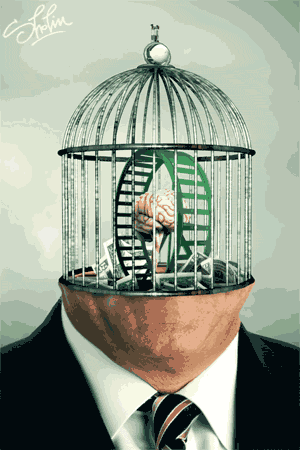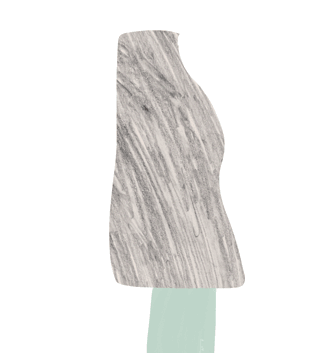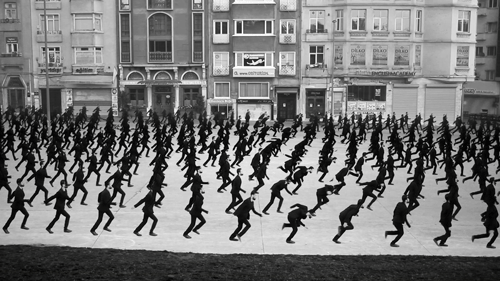Avant-GIFs
Turning online animations into high art
Once upon a time, a motion picture lasted somewhere between 90 and 120 minutes. Film shorts weren't entirely dead, but they were limited to classroom movies, music videos, and other relatively marginal outlets. From time to time a TV channel would show a miniseries, allowing writers and directors to tell a longer story. But those too were exceptions. If moving pictures were your medium of choice, you were expected to accept fairly rigid time constraints.
Today those limits have been shattered. Thanks to cable, DVDs, and Internet streaming, television now has room for stories that extend for dozens of hours but—unlike an old soap opera—follow from a storytelling vision sketched out in advance by just a few writers, or even by one man writing alone. On the other end of the spectrum, there has been a vast online revival of short films. A format virtually everyone had written off a decade and a half ago is now probably more widely watched than those feature-length pictures you see in the theater.
And then there is the animated GIF, simultaneously the shortest variety of motion picture (just a few seconds) and the longest (those seconds loop forever). As a technology, these have existed since 1987, but they've only just recently exploded in popularity, as mass access to the Internet allowed them to travel rapidly and virally online. The most popular GIFs are tiny snippets from movies and TV, ripped from one context and plugged into another: a disposable little gag to stick in a Tumblr post or a BuzzFeed article. But serious artists are working with GIFs too—photographers who want to introduce motion to their images, animators more interested in crafting a moment than telling an extended story, cartoonists who'd like to let some of their panels move, collagists delighted to have an extra dimension to play with. All creating strange and striking micro-movies.
Take Milos Rajkovic, a.k.a. Sholim, whose GIFs feel like a Max Ernst collage crossed with one of Terry Gilliam's animations from Monty Python's Flying Circus. In Manager, most of a man's head has been replaced by a birdcage lined with money; in the middle of a cage, a tiny brain runs on a hamster wheel. In Skinner Box Head, holes in a man's face reveal that he's a machine—and in the center of the head, where the brain ought to be, a chicken pecks repeatedly at part of the mechanism. Sholim loves to open people's skulls to reveal contraptions as complicated as any Rube Goldberg cartoon, but while the typical Goldberg machine is a ridiculously elaborate means to accomplish a simple goal, Sholim's creations spin purposelessly forever.

Lilli Carré's GIFs, meanwhile, are drawings that move. Sometimes they tell a tiny story: a woman eats an infinite supply of flowers (rose hips), balloons pop and fall to Earth (oh brother), an item repeatedly emerges from a woman's body to pierce her in the back (lil' self-sabotage). Other Carré GIFs, like the staggering strange snow, look like abstract expressionist paintings come to life.

The Turkish artist Erdal Inci is obsessed with cloning—not the biological process but the photographic one, in which the same person appears several times in a single image. Combining cloning with movement, Inci's GIFs frequently feature hordes of identical men performing the same action again and again. The effect is spooky, hypnotic, and occasionally comic: Inci's Stumblers, in which a mob trips en masse, looks like the climax of a Buster Keaton film.

Then there's Tiago Spina, a São Paulo artist whose efforts fall into so many styles that it's hard to generalize about his work. My favorite Spina GIF is Processo Criativo, in which an old-fashioned woodcut-style image of a man deep in thought is transformed by something you could never see in an actual woodcut: a pulsating orange light.
The animated GIF is not the first species of motion picture to combine brevity and eternity in this way, with a simple sequence repeating potentially forever. In the 19th century, optical toys with peculiar names—zoetropes, praxinoscopes, zoopraxiscopes—created the illusion of motion by showing a succession of images in rapid sequence, helping pave the way for the movies. But unlike a 20th-century film (and unlike other 19th-century moving picture amusements, such as the flipbook) they span in a circle rather than progressing from beginning to end. Some of them feel surprisingly modern, even psychedelic.
How do I know what those ancient motion pictures look like? Because fans of early cinema have posted many of them online. Frequently as GIFs.
Show Comments (61)